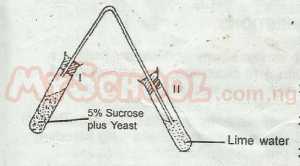Year :
1997
Title :
Biology
Exam :
WASSCE/WAEC MAY/JUNE
Paper 1 | Objectives
31 - 40 of 59 Questions
| # | Question | Ans |
|---|---|---|
| 31. |
Flatworms are classified as A. Platyhelminthes B. coelenlerata C. annelida D. nematoda E. arthropoda |
A |
| 32. |
The essential parts of a flower are A. petals and sepals B. anther and filament C. stigma and style D. androecium and gynoecium E. petals and gynoecium |
D |
| 33. |
Which of the following parts of the tooth is first damaged during dental decay? A. Cement B. Enamel C. Dentine D. Root E. Gum |
B |
| 34. |
 The set- up above is used to demonstrate A. plasmolysis B. osmosis C. suction pressure D. fermentation E. diffusion |
D |
| 35. |
 What will be the colour of the solution in the test tube labelled II at A. Pink B. Yellow C. Milky D. Reddish white E. Blue-black |
C |
| 36. |
 Which gas will pass into the test tube labelled II from I? A. Carbon monoxide B. Carbon dioxide C. Oxygen D. Ammonia E. Nitrogen |
B |
| 37. |
In which of these forms is carbohydrate stored in yam? A. Glucose B. Maltose C. Starch D. Glycogen E. Cellulose |
C |
| 38. |
Northern Guinea savanna is associated with A. abundant rainfall B. abundant trees and shrubs C. soil with very little plant cover D. abundant grasses E. high humidity |
D |
| 39. |
Which of the following activities is not necessary in population sampling? A. Selecting the habitat B. Dividing the selected habitat into portions C. Throwing the quadrat randomly D. Counting the number of organisms E. Feeding the organisms |
E |
| 40. |
Which of the following is an abiotic factor? A. Predation B. Rainfall C. Cropping D. Grazing E. Migration |
B |
| 31. |
Flatworms are classified as A. Platyhelminthes B. coelenlerata C. annelida D. nematoda E. arthropoda |
A |
| 32. |
The essential parts of a flower are A. petals and sepals B. anther and filament C. stigma and style D. androecium and gynoecium E. petals and gynoecium |
D |
| 33. |
Which of the following parts of the tooth is first damaged during dental decay? A. Cement B. Enamel C. Dentine D. Root E. Gum |
B |
| 34. |
 The set- up above is used to demonstrate A. plasmolysis B. osmosis C. suction pressure D. fermentation E. diffusion |
D |
| 35. |
 What will be the colour of the solution in the test tube labelled II at A. Pink B. Yellow C. Milky D. Reddish white E. Blue-black |
C |
| 36. |
 Which gas will pass into the test tube labelled II from I? A. Carbon monoxide B. Carbon dioxide C. Oxygen D. Ammonia E. Nitrogen |
B |
| 37. |
In which of these forms is carbohydrate stored in yam? A. Glucose B. Maltose C. Starch D. Glycogen E. Cellulose |
C |
| 38. |
Northern Guinea savanna is associated with A. abundant rainfall B. abundant trees and shrubs C. soil with very little plant cover D. abundant grasses E. high humidity |
D |
| 39. |
Which of the following activities is not necessary in population sampling? A. Selecting the habitat B. Dividing the selected habitat into portions C. Throwing the quadrat randomly D. Counting the number of organisms E. Feeding the organisms |
E |
| 40. |
Which of the following is an abiotic factor? A. Predation B. Rainfall C. Cropping D. Grazing E. Migration |
B |